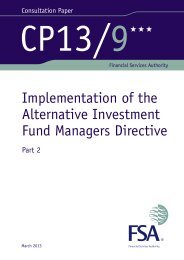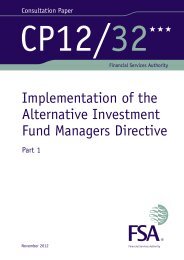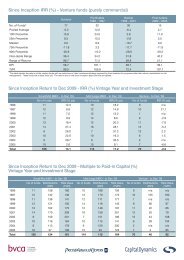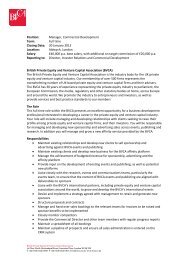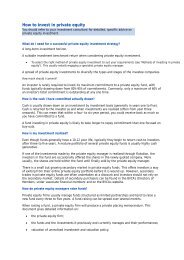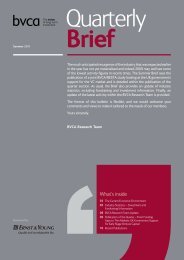A Guide to Private Equity - BVCA admin
A Guide to Private Equity - BVCA admin
A Guide to Private Equity - BVCA admin
Create successful ePaper yourself
Turn your PDF publications into a flip-book with our unique Google optimized e-Paper software.
in repaying much higher levels of debt, financial engineering and multiple arbitrage have become<br />
less important. Buyouts are now much more dependent on operational improvements and<br />
earnings enhancement <strong>to</strong> generate value.<br />
Buyout structure<br />
The financial structure of a management buyout deal is carefully tailored <strong>to</strong> the cash and profit<br />
generating characteristics of the company that is the subject of the buyout.<br />
A special purpose vehicle (Newco), which is a separate legal entity and usually a limited company with<br />
local or offshore incorporation, is created <strong>to</strong> make the acquisition of the target company (the company<br />
subject <strong>to</strong> the buyout). The equity capital is provided <strong>to</strong> Newco by the private equity firm and the<br />
management team. Bank (loan) finance is used <strong>to</strong> part fund the purchase of the target and <strong>to</strong> provide<br />
working capital. The security for the bank finance is the target’s fixed assets, operating assets, book<br />
debts plus usually a charge from Newco over the capital it will hold in the target. The funding is only<br />
committed once the acquisition actually takes place.<br />
Simple buyout structure<br />
Vendors:<br />
loan notes<br />
Banks:<br />
senior debt<br />
NEWCO<br />
TARGET CO<br />
Inves<strong>to</strong>rs:<br />
shares/loan notes<br />
Managers:<br />
shares<br />
The use of debt in the form of the bank loans helps maximise the equity returns, eg. a debt/equity ratio<br />
of 80/20 can double the return on equity that would be achieved by a debt/equity ratio of 20/80. The<br />
debt element of the transaction has his<strong>to</strong>rically been between 70% and 95% of the <strong>to</strong>tal finance required.<br />
Debt finance in a management buyout transaction<br />
Banks can produce a blend of debt instruments, matched <strong>to</strong> their varying appetites for risk and<br />
demands for return and tailored <strong>to</strong> the forecast cash generating capacity of the target company. The<br />
range of debt products include senior debt, including revolving loans, term loans, capex term loans,<br />
second lien debt, mezzanine finance and high yield bonds, all of which rank behind the senior debt<br />
in terms of security and repayment in the event of a liquidation. There might also be the possibility of<br />
vendor financing from the seller of the company being acquired or an earn-out arrangement (deferred<br />
purchase consideration).<br />
The return (usually in the form of interest) expected by the debt provider increases as the risk increases.<br />
Senior debt is secured on collateral, usually the assets of the target being acquired pledged as security<br />
for the loan. In the event that the borrower defaults on the terms of the loan, the assets may be sold,<br />
with the proceeds used <strong>to</strong> satisfy any remaining obligations. High-quality collateral reduces the risk <strong>to</strong><br />
the lender and results in a lower rate of interest on the loan. In the event of bankruptcy, the senior debt<br />
provider is considered a secured credi<strong>to</strong>r, which means the credi<strong>to</strong>r receives proceeds from the sale of<br />
the collateral <strong>to</strong> satisfy the debt. Secured credi<strong>to</strong>rs, including the senior debt provider, must have their<br />
debts satisfied before any unsecured credi<strong>to</strong>rs receive any funds.<br />
Other than straight cash, senior debt has the lowest risk financing, has the highest priority for interest<br />
and principal repayments and therefore requires less in terms of return (interest payments). Interest<br />
also increases proportionate <strong>to</strong> the term of the loan.<br />
The investment process<br />
A <strong>Guide</strong> <strong>to</strong> <strong>Private</strong> <strong>Equity</strong> 33



